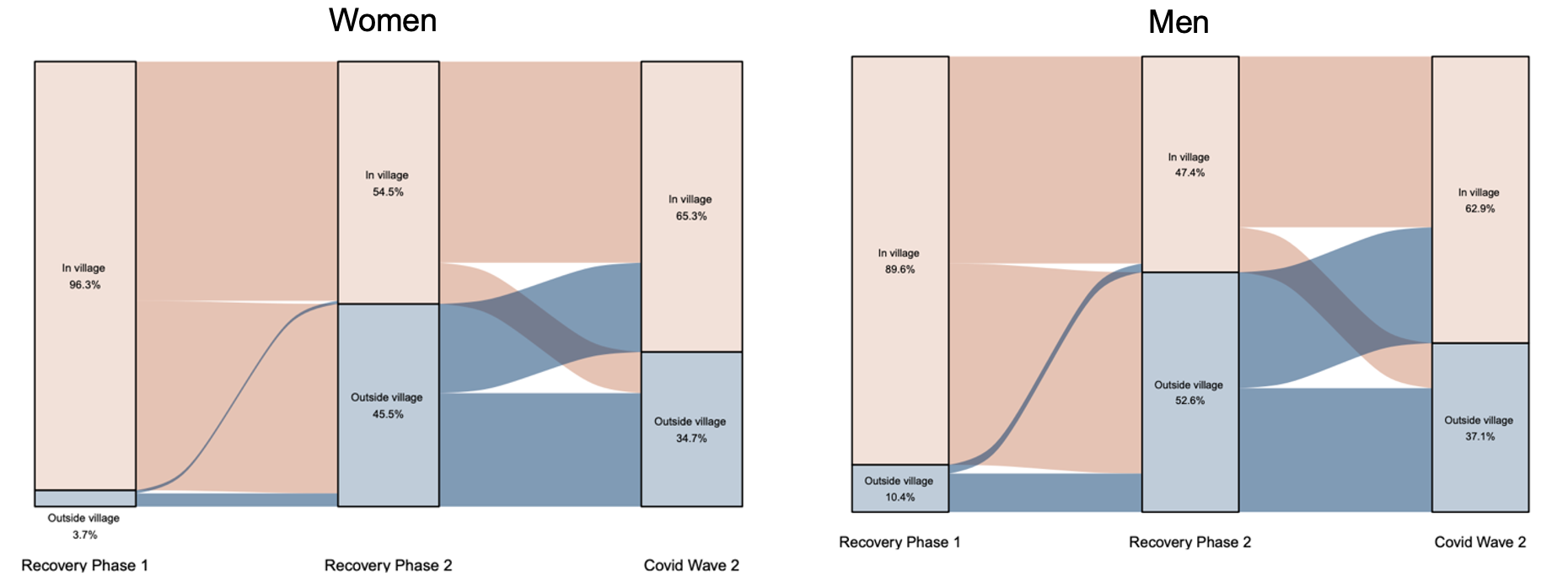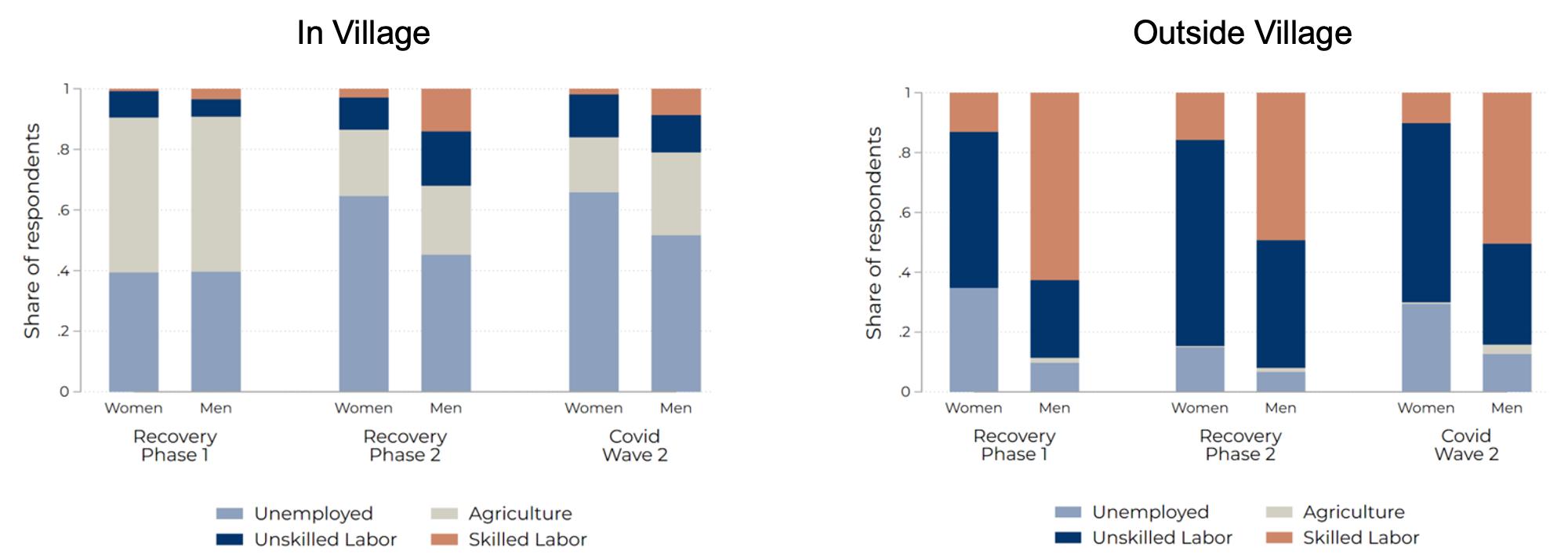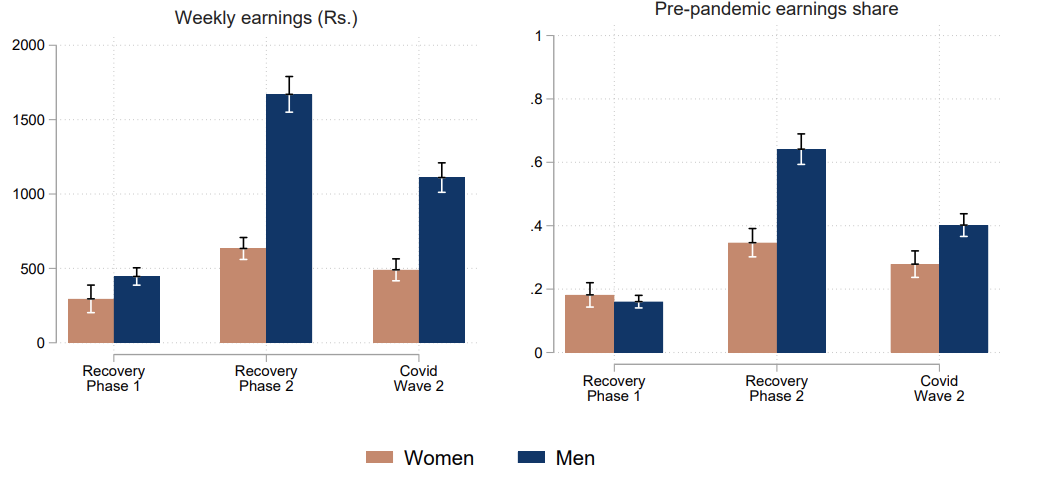In India's "invisible workforce" women face a slower economic recovery from Covid-19
Inclusion Economics researchers tracked 5,000 migrant workers who returned to their home villages following the first Covid-19 lockdown to measure the economic effects of the pandemic.

Indian Female Migrants Face Greater Barriers to Post-Covid Recovery than Males: Evidence from a Panel Study
Inclusion Economics Research Summary, October 2022
The abrupt Covid-19 lockdown imposed by India in March 2020 forced millions of urban workers to return to their distant rural homes. How did they fare in the year that followed?
Collecting data on a poorly documented population on the move is hard, and most studies of India’s pandemic-displaced internal migrants rely on small samples of those who are easiest to reach. A new study, however, by a team of researchers affiliated with Inclusion Economics at Yale University enrolled approximately 4,600 displaced migrants and followed them from April 2020 through July 2021 as they returned to two of India’s poorest states. According to the study, the disruption in their labor force participation has had far-reaching, long-term consequences, and women continue to face greater barriers to economic recovery than men.
Displaced migrants experienced persistent hardships for over a year after the initial pandemic lockdown, with women faring worse. Some women dropped out of the labor force entirely, but most unemployed reported seeking or being available to work.
Remigration is critical to regaining income, but women were both less likely to do so and benefitted less. By the end of the study, no more than 63 percent of mean and 55 percent of women had ever remigrated. In July 2021, male re-migrants earned, on average, 82 percent of their pre-pandemic income, while female remigrants earned only 56 percent.
Gender gaps in income recovery largely reflect higher rates of unemployment among women, both among those remaining in their villages and among those who remigrated.
Domestic rural-urban migration is how many low-income households escape poverty, and it is also an important contributor to economic growth. The inability of return migrants to reintegrate into urban labor markets both threatens household well-being and economic growth. Understanding the economic costs of the pandemic for India’s poor requires documenting the labor market reintegration of India’s internally displaced migrant workers.
And, in a country marked by low and declining female labor force participation, identifying gender gaps in labor market reintegration – as a marker of both women’s vulnerability at times of crisis and setbacks in women’s agency – is especially important. Indian women are some of the least employed in the world, with only 18.6 percent in the labor force per the nationally representative 2018-19 Periodic Labor Force Survey (PLFS), and rural women’s labor force participation has declined over the past 20 years. Research shows that women’s access to higher-paying formal sector jobs – such as those more widely available in urban areas – increases women’s career aspirations while delaying marriage and childbearing, which is, in turn, associated with better outcomes for women and their families.
All of this suggests that Covid-induced job dislocation and urban displacement may have long-term negative consequences for a female migrant’s agency and her family’s well-being. It also highlights the importance of ensuring a gender focus in studies of pandemic-displaced internal migrants .
Findings
Remigration was more difficult for women than men, which may have had significant effects on their economic and social standing.
The figure below shows that 90 percent of men and 96 percent of women were in their home villages during recovery phase 1 (July 2020), more than a month after the nationwide lockdown ended. By recovery phase 2 (January 2021), 53 percent of men and 46 percent of women were outside their home villages. Yet just 37 percent of men and 35 percent of women remained outside their home village as of Covid wave 2 (June 2021), reflecting a new round of migrant returns that coincided with the Delta variant wave. Looking across waves, 63 percent of men remigrated at least once, compared to 55 percent of women.

Women are more likely than men to remain unemployed, even if they remigrate..
While overall unemployment rates in the immediate aftermath of the lockdown are similar for both genders (36 to 40 percent), unemployment among women steadily grows throughout the observation period. Men, in contrast, were more likely to find work over the longer term. This reflects two phenomena:
- Unemployed women are more likely to remain unemployed than men.
- Women who were working are significantly more likely to become unemployed than their male peers.
Higher rates of female unemployment do not simply reflect lower rates of remigration – the figure below shows that women are more likely than men to remain unemployed even if they remigrate.

As the economy improved, male but not female migrant income rebounded significantly.
While the Delta variant induced a second round of wage decreases, men continued to outpace women in June 2021, earning Rs 1,111 per week on average compared to women’s weekly earnings of Rs 490. This represents 40 percent of pre-lockdown earnings for men compared to 28 percent for women.

Persistent gender gaps in outcomes
When agricultural jobs become scarcer as economies modernize and industrialize, many rural families move to the city as a path out of poverty. For Indian women in particular, moving from the countryside to the city may be a life-changing experience since it opens doors to better employment opportunities, including greater wages. Against this background, we demonstrate that the Covid-19 outbreak exacerbated preexisting gender gaps in outcomes for internally displaced people.
This research shows that the long-term impacts of the pandemic on women are cause for concern, especially in regards to their access to meaningful work in urban labor markets. As the post-pandemic problems of female migrant workers have shown, there is an urgent need to investigate the obstacles women face in the workforce and identify measures that can help them gain access to high-paying positions.
Research Summary by Zahrah Abdulrauf